Santorini is small enough to see in a few days, but getting around can still catch first-time visitors off guard. The roads are narrow and winding, buses get packed in peak season, and there are only a handful of taxis to go around. Add in the heat and crowds, and even a short trip from Fira to Oia can feel like a bit of a mission.

Image Credit: Russell_Yan via Canva Pro
That’s why one of the biggest questions travellers ask is: Should I rent a car? It sounds convenient at first, but it’s not always the best choice for everyone. Between buses, scooters, private transfers, and even cable cars, there’s a mix of transport options, each with its own pros, trade-offs, and hidden surprises.
This guide breaks it all down to help you figure out what works best for your trip. Whether you’re looking for comfort, flexibility, or just the cheapest option, here’s how to get around Santorini without losing your patience or your luggage.
Also read: 10 Breathtaking Beaches in Greece, Grouped by the Vibe You’re Chasing.
Public buses: Cheap, surprisingly reliable, and good enough
If you’re not keen on driving, Santorini’s public bus network is a solid way to get around. It’s run by KTEL and connects most key areas, including Fira, Oia, Kamari, Perissa, and the airport. Fares are affordable, usually between €1.60 and €2.50 (S$2.30–S$3.60) depending on how far you’re going.

Image Credit: Santorini Bus Official Website
Most routes start or pass through Fira, the island’s main hub. This means even if you’re travelling between two other towns, you’ll probably need to change buses there. It’s not always the fastest route, but it gets the job done.
Buses run pretty frequently during peak season (every 30 to 60 minutes), though delays and crowding are common in summer. They don’t take reservations, and there’s no fancy app for the buses. Just pay in cash on board, find a seat if you can, and hold on tight.
When buses work best:
-
You’re staying near Fira or using it as a base
-
You don’t mind waiting a bit during busy hours
-
You’re visiting popular spots like Kamari Beach or the port
-
You’re travelling light (space can be tight for luggage)
Tripzilla Tip: Screenshot the latest timetable or pick one up at the Fira station. Some beach routes run less often in the evenings, so plan your return trip ahead.
3. Taxis and private transfers: Comfortable but not always reliable
At first glance, a taxi sounds like the easiest option. Just hop in, relax, and you arrive. But in Santorini, that’s not always how it plays out.
There are only around 40 to 50 taxis on the entire island, and demand skyrockets in summer. You’ll find taxi stands near the Fira bus station, the airport, and Athinios ferry port, but availability can be unpredictable. It’s not uncommon to wait 30 minutes or more, especially if you’re arriving at the same time as a ferry crowd.
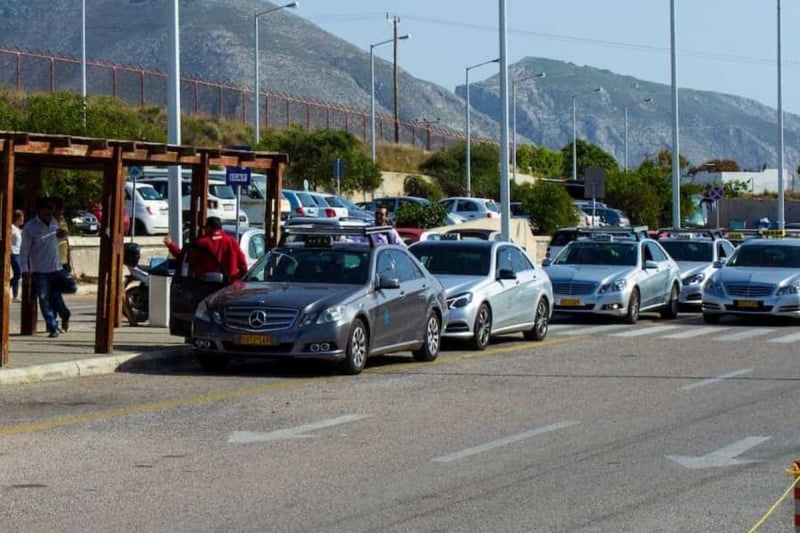
Image Credit: Santorini Airport Official Website
There’s no Uber on the island, and local ride-hailing apps like Aegean Taxi or iMove exist, but are spotty at best. Most travellers rely on calling ahead or asking their hotel to book one.
Average taxi costs:
-
Port to Fira: ~€30 (S$45)
-
Port to Oia: ~€40–€45
-
Luggage or late-night rides may cost more
If you’d rather not deal with the uncertainty, private transfers are your safest bet. They’re slightly pricier but can be booked in advance through your hotel or online. Some hotels also offer port or airport pickups at a fixed rate (often ~€20–€25).
When this makes sense:
-
You’re arriving late or travelling with kids/luggage
-
You want a guaranteed ride with no haggling
-
You’re staying in a remote area without bus access
Tripzilla Tip: If you’re taking a taxi to the beach or a dinner spot, ask the driver if they can pick you up again later (arranging a return trip saves you the scramble).
4. Scooters and ATVs: Fun, flexible, but not for everyone
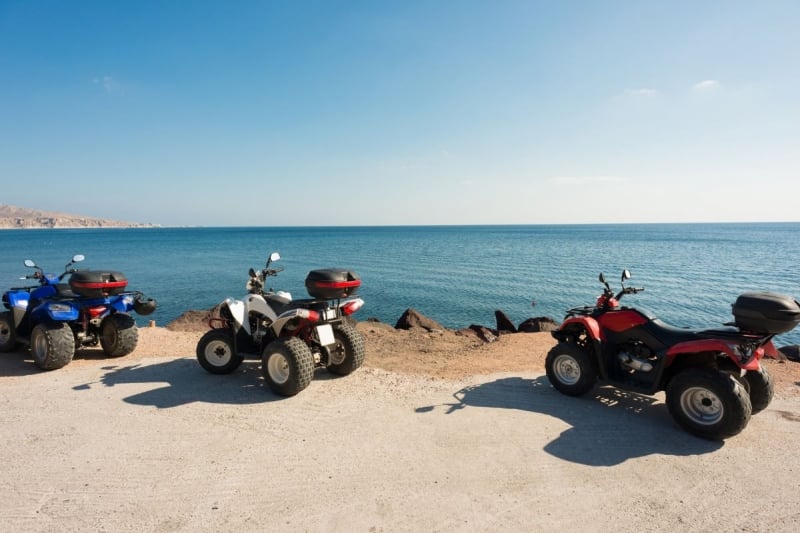
Image Credit: stockstudioX via Canva Pro
If you’ve ever scrolled through Santorini travel reels, you’ve probably seen someone zipping along a cliffside road on an ATV with the wind in their hair. It looks like freedom, and feels like it, too. ATVs and scooters are popular for a reason: they’re cheaper than cars, easier to park, and a great way to explore at your own pace.
But there are a few important things to know before you hop on.
First, you’ll need the right license. For non-EU travellers, that often means bringing an International Driving Permit (IDP) alongside your national license. Some rental shops might let it slide, but legally, it’s required, especially for motorbikes. Helmets are also mandatory, though not always enforced.
Second, Santorini’s roads can be unpredictable. Think blind curves, steep inclines, and cars speeding around corners. It’s not the best place for your first scooter ride ever. If you’re confident on two wheels, you’ll likely be fine. Just drive defensively and don’t rush.
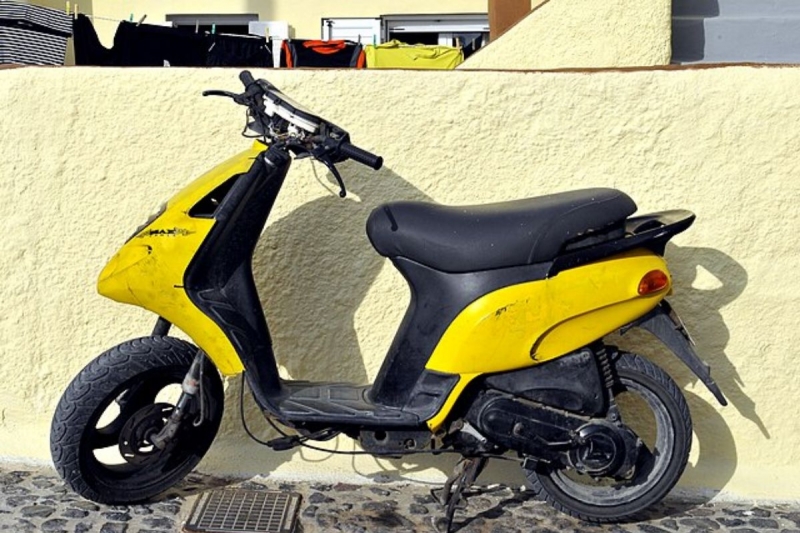
Image Credit: LBM1948 via Wikimedia Commons
What you can expect:
-
Rental prices: Around €25–€40 per day for ATVs, less for scooters
-
Fuel: Not always included, so top up before heading out
-
Parking: Much easier than with a car, especially in Oia and Fira
Tripzilla Tip: If you’re new to this, consider renting an ATV instead of a scooter. It offers more stability and doesn’t require the same balance or licensing in some cases, though you should still double-check local rules.
Also read: 7 Irresistible Reasons to Visit Folegandros, a Little-Known Island in Greece.
Cable cars, boats, and walking: Scenic, slow, and sometimes underrated
Not every mode of transport in Santorini is about getting from point A to B as fast as possible. Some are worth doing because they’re scenic and a little slower, like floating past volcanic cliffs or taking in the caldera on foot.
Cable car

Image Credit: Andrey X. via Canva Pro
In Fira, a small cable car runs between the old port (Skala) and the town above. It was originally built for cruise ship passengers, but anyone can ride it.
-
Fare: €6 (S$9) one-way
-
When to use it: If you’re visiting from a cruise, or just want to avoid the 600+ steps.s
-
What to expect: Stunning views during the short 2-minute ride, but long queues when ships are docked
Boats
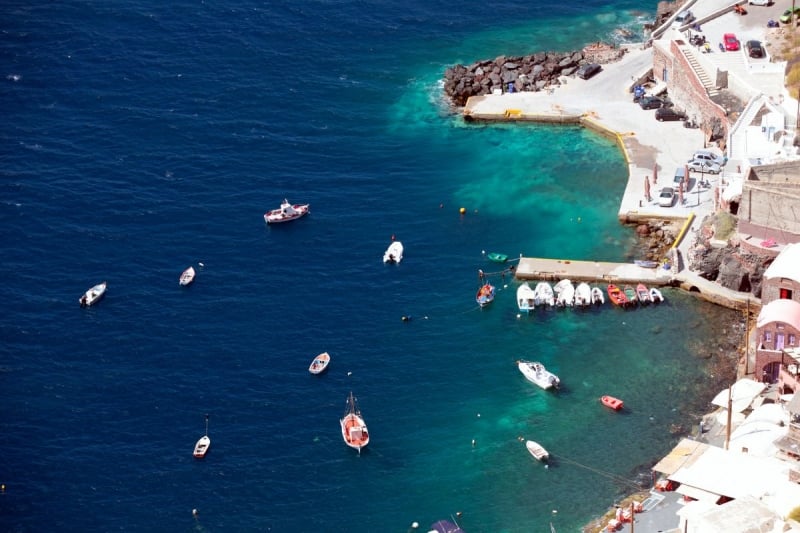
Image Credit: tkachuk via Canva Pro
Santorini’s coastline is rugged, so boats are often the best way to visit hidden beaches or the volcanic islands in the caldera. Some beaches — like White Beach and Mesa Pigadia — are hard to access by road and much easier to reach by water taxi or tour.
-
Day tours: Start around €40 (S$60) and may include snorkelling, hot springs, or stops on Thirassia
-
Local boats (caïques): Can be hired from some beaches to reach nearby coves
-
Ferries: Also run to nearby islands like Thirassia for as little as €2.10
Walking

Image Credit: trantanvp99 via Canva Pro
Santorini isn’t very large, but it’s very vertical. Walking around towns like Oia and Fira is scenic but involves lots of stairs and uneven paths. One of the most famous hikes — the Fira to Oia trail — takes 2.5 to 3 hours and rewards you with sweeping caldera views along the way.
-
Best time to walk: Early morning or just before sunset
-
Don’t forget: Water, sunscreen, and proper shoes
-
Not ideal for: Anyone with mobility issues — most of the island is not wheelchair-friendly
Tripzilla Tip: Don’t rely on walking for regular transport unless you’re staying in a central area. It’s great for exploring, but not realistic for beach hopping or getting to/from ports.
So… should you rent a car in Santorini?
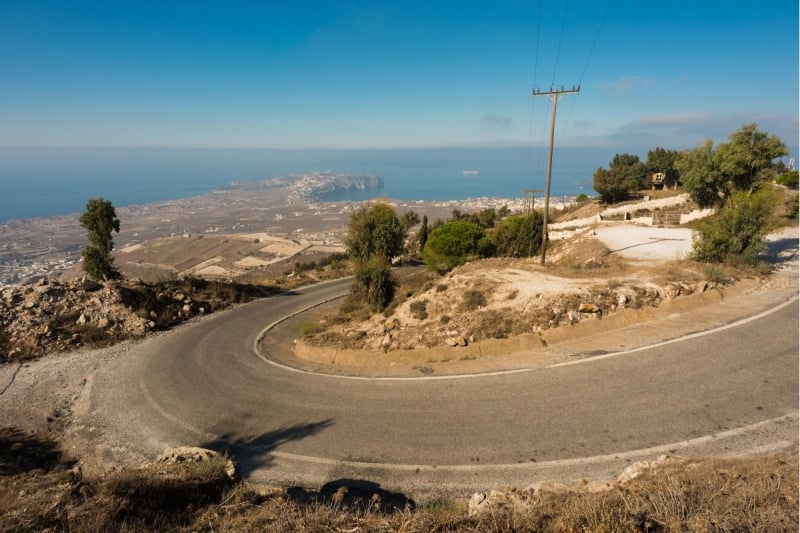
Image Credit: stockstudioX via Canva Pro
Now that you’ve seen what the island’s transport options are like, you might be circling back to the big question: Wouldn’t renting a car just be easier?
The honest answer is: it depends.
A rental car gives you full freedom to explore at your own pace. You won’t have to plan your day around bus schedules or queue for taxis, and you’ll have access to off-the-beaten-path spots like Pyrgos, Vlychada Beach, or far-flung wineries in the south. If you’re staying somewhere remote or travelling with young kids or elderly family, having your wheels can be a game-changer.
But it comes with trade-offs.
Santorini’s roads are narrow and often crowded in summer. Parking in towns like Oia and Fira is chaotic at best, and you risk fines if you leave your car in the wrong spot. Fuel and rental costs also climb quickly in high season, and you’ll need an International Driving Permit (IDP) if your license isn’t from the EU.
When it makes sense:
-
You’re travelling in a group and can split costs
-
You’re staying in a less central area
-
You’re visiting in spring or autumn when the roads are quieter
-
You only need it for one or two days to explore
Tripzilla Tip: Many travellers rent a car for just part of their trip, and use buses or transfers the rest of the time. This way, you get the freedom without the full-time stress.
Final tips for getting around Santorini

Image Credit: Maridav via Canva Pro
-
Book in advance if you’re visiting during peak season. That goes for rental cars, transfers, and even ATVs — things sell out fast in summer.
-
Bring cash for buses and small boat rides. Most public transport doesn’t take cards, and smaller vendors may not have change.
-
Download offline maps (like Google Maps or Maps.me) before you go. The signal can be spotty in certain areas.
-
Plan your day by region. Since most bus routes hub through Fira, grouping your activities by area — for example, doing Oia and Imerovigli on the same day — can save a lot of backtracking.
-
Avoid driving in Oia around sunset unless you’re prepared to crawl through traffic and circle for parking. It’s beautiful, but you won’t enjoy it from behind the wheel.
-
Check your license requirements before renting any vehicle. The rules around IDPs are real, even if not every vendor enforces them.
The bottom line:
Getting around Santorini isn’t complicated once you know what to expect. Pick the mode of transport that fits your vibe, keep your plans flexible, and focus on soaking in the views, whether you’re on a scooter, a bus, or just your own two feet.
Also read: Beyond Santorini and Mykonos: 8 Fairytale Islands in Greece You Need to Visit.
Final thoughts

Image Credit: KavalenkavaVolha via Canva Pro
Santorini’s charm lies in its contrasts — cliffside stillness and tourist chaos, barefoot walks and steep uphill climbs, spontaneous sunset moments and jam-packed buses. Getting around the island isn’t always seamless, but it’s part of what makes the experience feel real.
Whether you choose to rent a car, hop on a crowded bus, or ride the cable car just for the view, the best transport choice is the one that matches your pace, your priorities, and your patience. You don’t need to see everything to have a good trip. Sometimes the slow route (or the slightly inconvenient one) ends up being the most memorable.
Featured Image Credit: Hodor via Canva Pro





